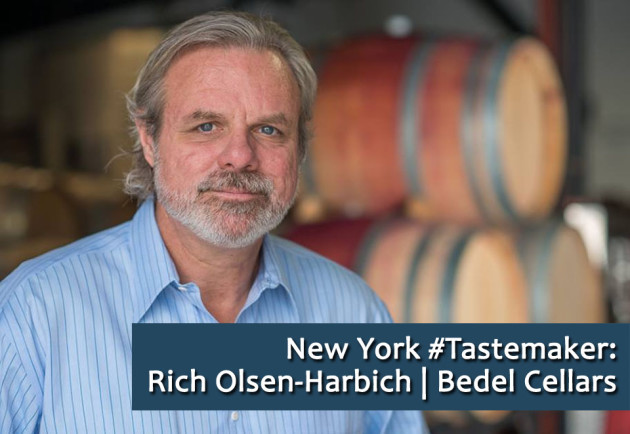“Tastemaker” is a term typically used to describe a person — either a sommelier or writer in the wine world — who decides what is good, cool or otherwise interesting. With our new #NYTastemaker profiles, I’ve decided to usurp the term to mean someone who actually makes the wines, ciders, spirits, etc. that we love. A “tastemaker” should make something, after all.
I’m not sure that Rich Olsen-Harbich, winemaker at Bedell Cellars will ever let me live down the fact that I once wrote that while he’s not the founding father of Long Island wine, he’s the region’s “eldest uncle.” It’s perhaps not my best turn of phrase, but that doesn’t make it any less true. He wasn’t the first, but he got here right after the Hargrave’s started. He authored the Long Island’s three official American Viticultural Areas (AVAs), has worked at two of the region’s most important producers (Bedell and Raphael before that) and no one questions his place the past, present and future of Long Island wine.
Early on in my wine writing career, his knowledge and expertise were invaluable. He was always willing to answer my questions — silly or not — and even contributed several stories to this site over the years. He was my first wine mentor.
We don’t talk nearly as often these days, but there is no doubt that he’s an important tastemaker on the East Coast.
Location: Cutchogue, Long Island
Current Job: Winemaker at Bedell Cellars
Wine of the moment: 2010 Rocca di Castagnoli Chianti Classico
My winemaking style in 1-5 words: Authentic, refreshing, reflective and tasty
First bottle of wine I remember drinking: It was probably a homemade red currant wine that my grandfather used to make in the basement. My grandparents lived upstairs in our house and he grew the fruit in the backyard. I remember watching it bubble in the glass carboy he used. It was served at family holiday dinners. I remember that it tasted very sour to me.
How I wound up here: It’s the culmination of my life’s work of 30-plus years of growing grapes and making wine on Long Island. When Michael and Trent approached me to fill the position, I was thrilled. It’s a very creative environment for me and I couldn’t be happier.
My winemaking style — in more words: My style has definitely evolved over the last three decades but I think I’ve really zeroed in on it. I stopped using commercial yeast about a decade ago so that’s really helped me see what’s going on in our terroir. My whites are based on harvesting to retain acidity – to keep them crisp and thirst-quenching and clean. With the reds I’m pretty much leaning in the same direction – ripe fruit flavors, soft mature tannins and balanced acidity. I’m using less oak as time goes on. I really love the bright fruit and don’t want oak interfering. I want my wines to be a sincere reflection of the North Fork and that means low-moderate alcohol, solid acidity and an elegant delicacy that can only be found here.
Mentors: Paul Pontallier, Hermann Wiemer, Larry Perrine and my father, Al Harbich.
Music playing in the cellar right now: My musical tastes seem to be going back in time. Right now it’s the Magnificat by C. P. E. Bach but I also listen to a lot of Artie Shaw and older jazz.
Favorite thing about Long Island wine industry: Aside from the delicious wines, the industry has helped preserve this beautiful area by continuing a centuries old agricultural tradition. I also love the surrounding water that provides so much pleasure to our lives.
Least favorite thing about Long Island wine industry: Can’t think of anything. I love everything about it. It’s who I am and what I’ve lived for basically my entire life.
One surprising thing that I’m really good at: I can play a mean 5 string banjo.
What I drink: Mostly Old World – French wines and the Loire makes some of my favorites, although I’m digging a lot of Italian reds at the moment from Barolo and Chianti. German and Austrian wines to me are like soul food. I like to drink small producers who are passionate about the wines they’re making.
My “Desert Island Meal” — wine included: Well since I’d be stranded I’d probably try to find some indigenous fruit to ferment to go with whatever I could catch.

